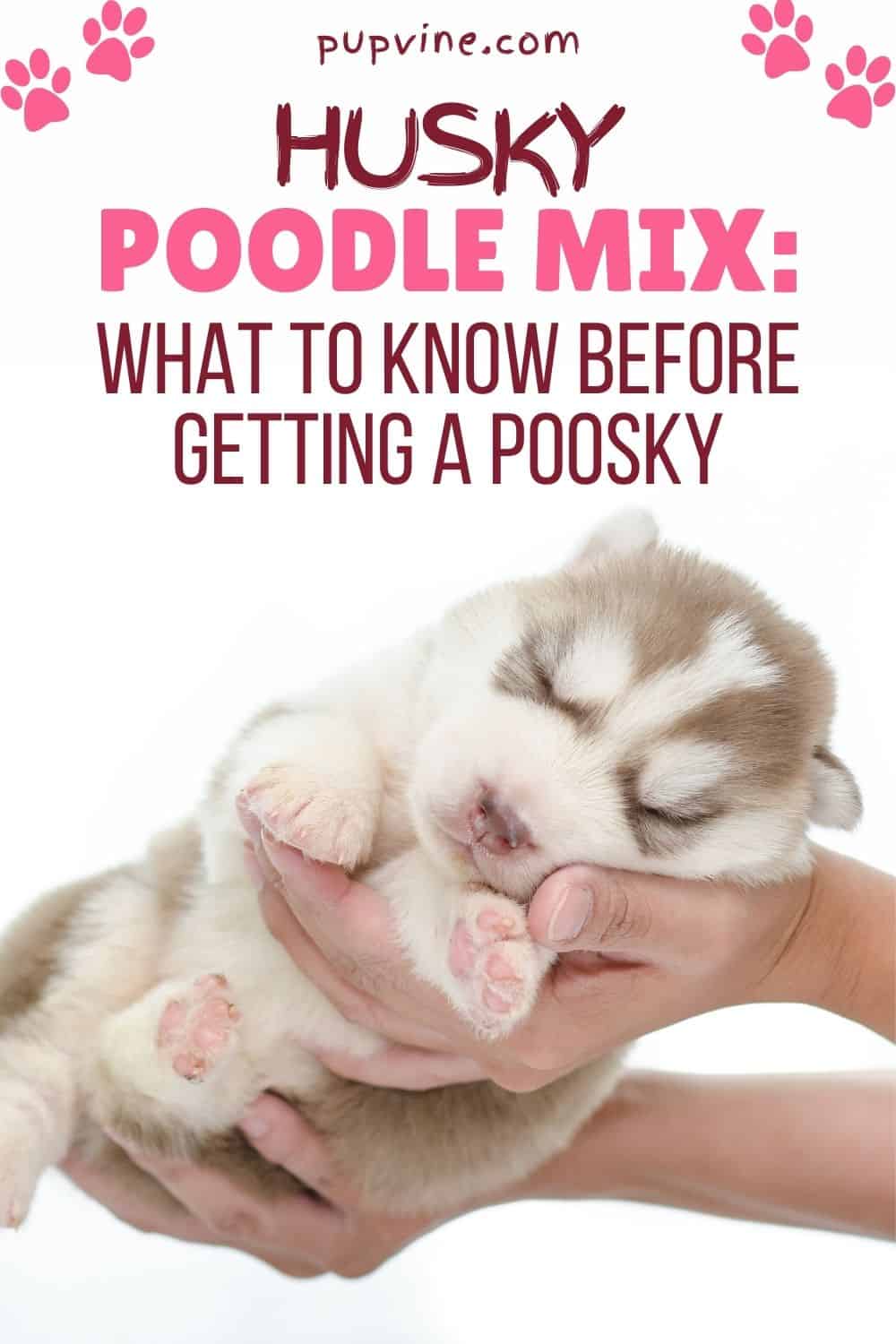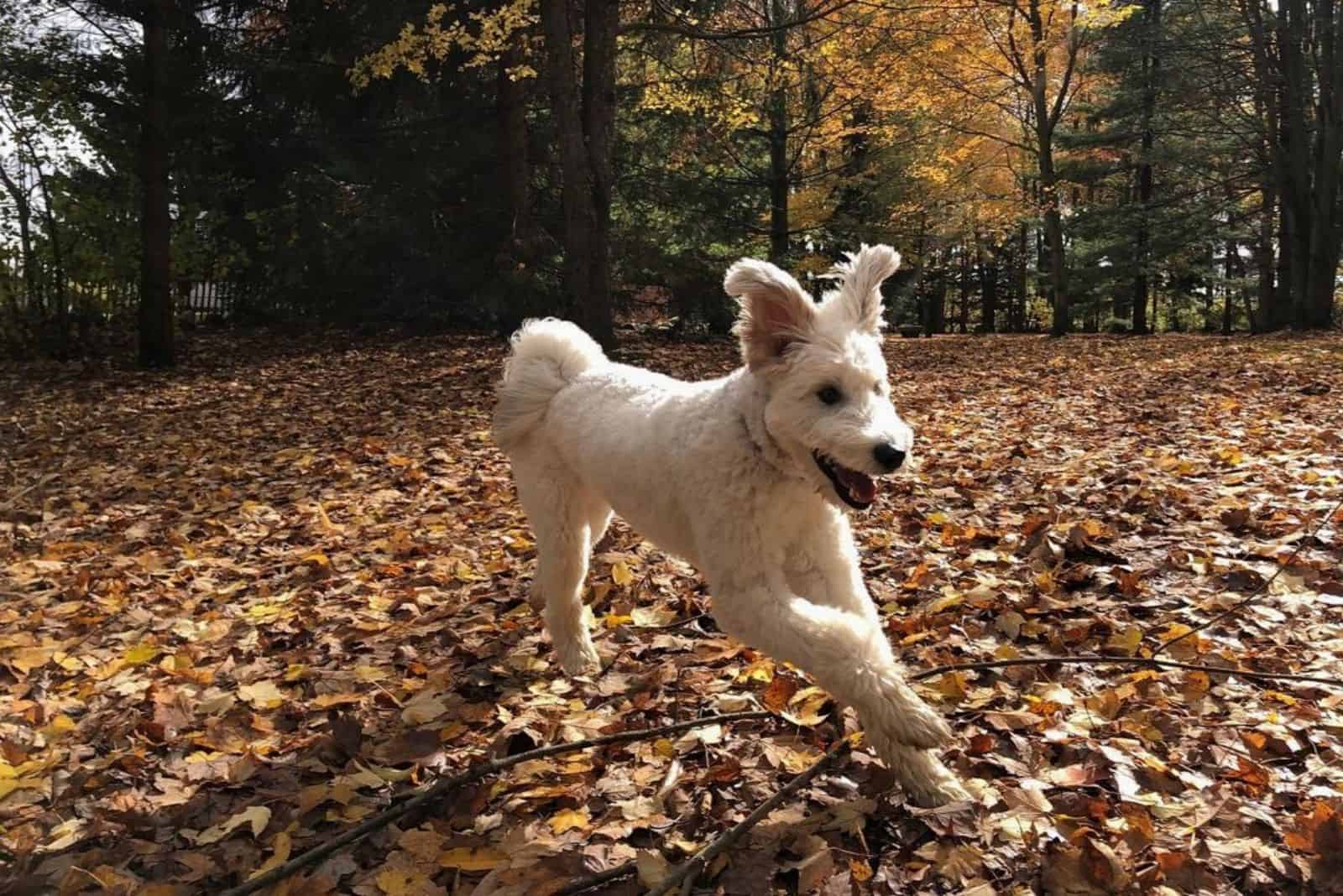Since the end of the 20th century, designer dogs have been continuously increasing in popularity, and among them, Poodle mixes are the favorites.
The Husky-Poodle mix is a crossbreed that resulted from mating a Siberian Husky with a Poodle, two working dogs that differ widely in looks and temperament. They’re not the most popular Doodles, but they have been gaining recognition in recent times.
With their parents being such different dog breeds, Huskydoodles can have an interesting combination of both physical and personality traits. These curious-looking, dynamic dogs have won over many hearts.
This article will help you see why that is and if you might be their next big fan.
What is a Husky Poodle mix?
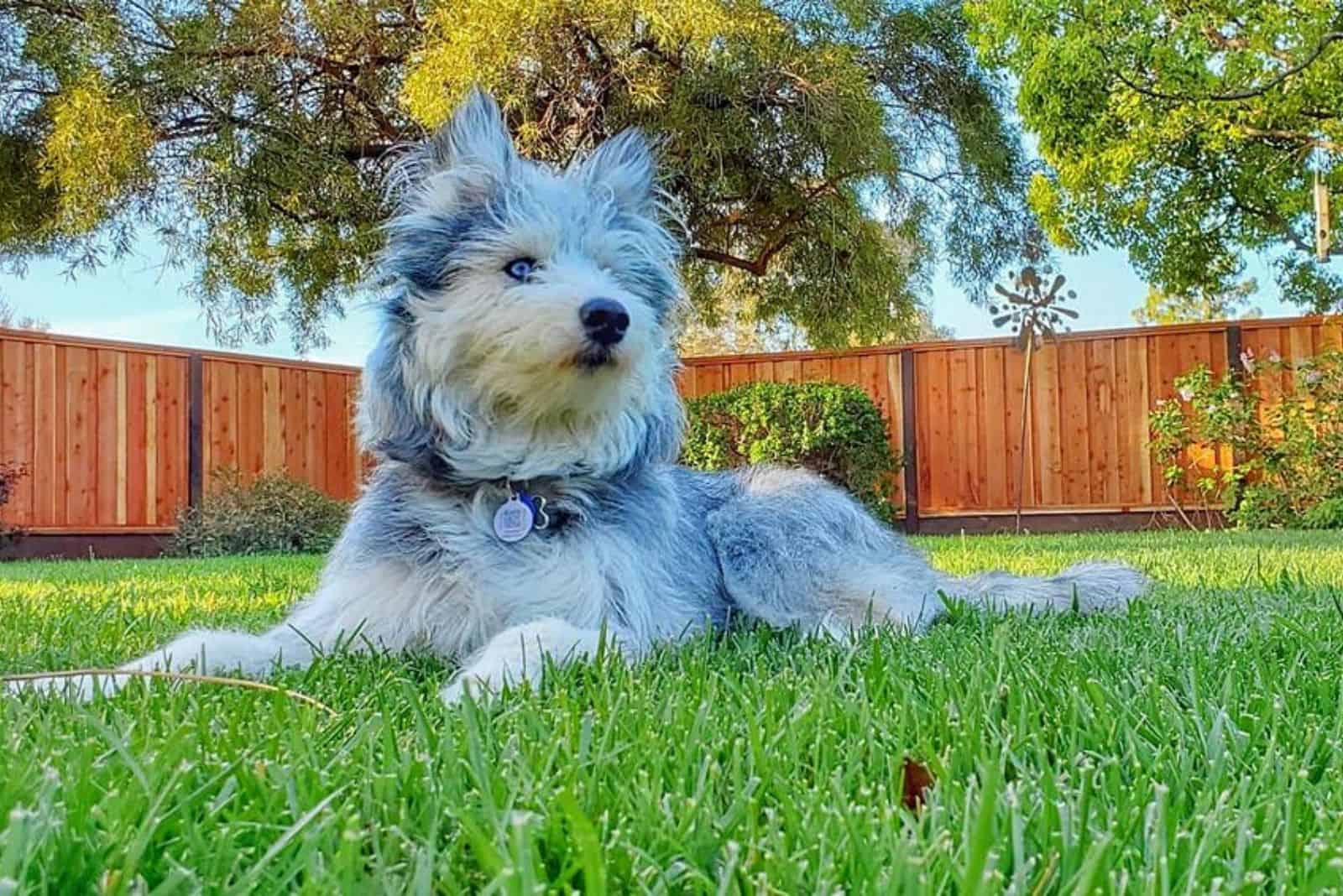
The Husky Poodle mix is a cross between a purebred Poodle and a purebred Siberian Husky. It’s not known where and when they first appeared. It’s possible breeders started breeding them by the end of the 20th century, when designer dogs began gaining popularity.
Designer or hybrid dogs are the terms used to describe crossbreed dogs deliberately bred from two purebred parents to combine desired traits and create a new breed with the best of both parent breeds.
The intention behind mixing these two dogs could have been to combine the Poodle’s intelligence, agility, and low-shedding coats with the Husky’s lively personality. Many other Doodles were created out of the need to have more allergy-friendly dogs, so it’s not far-fetched to assume that Pooskies were too.
Mixed dog breeds are not recognized by the American Kennel Club, but they are recognized by certain other dog organizations like the American Canine Hybrid Club (ACHC), the International Designer Canine Registry (IDCR), or the Dog Registry of America ( DRA ).
We may not know much about the Poosky ’s history, but we do know a lot about the history of its parent breeds.
Today, Poodles are known as elegant divas that often participate in dog-shows, but they were actually hunting dogs at first. It’s believed they originated in Germany about four hundred years ago, where they were used as retrievers for hunting waterfowl.
This is where their name comes from; the German word ‘ pudelin ’ means ‘to splash in water.’ Even their trademark haircut once served a practical purpose, making it easier to swim in the water while retrieving game and at the same time protecting their vital areas from the cold.
Their high trainability and interesting appearance soon made them popular among the nobles of Europe, especially in France, which is why they’re often mistaken as French dogs. Apart from their hunting jobs, they also have a long history in circus entertainment.
Huskies were initially working dogs as well. They were first bred by the Chukchi people of Siberia to be used as sled dogs. These dogs became widely known around the world after the heroic ‘Serum Run’ in 1925 when three Siberian Huskies saved the Alaskan town of Nome from a diphtheria epidemic by bringing them lifesaving medicine.
What does a Poosky look like?
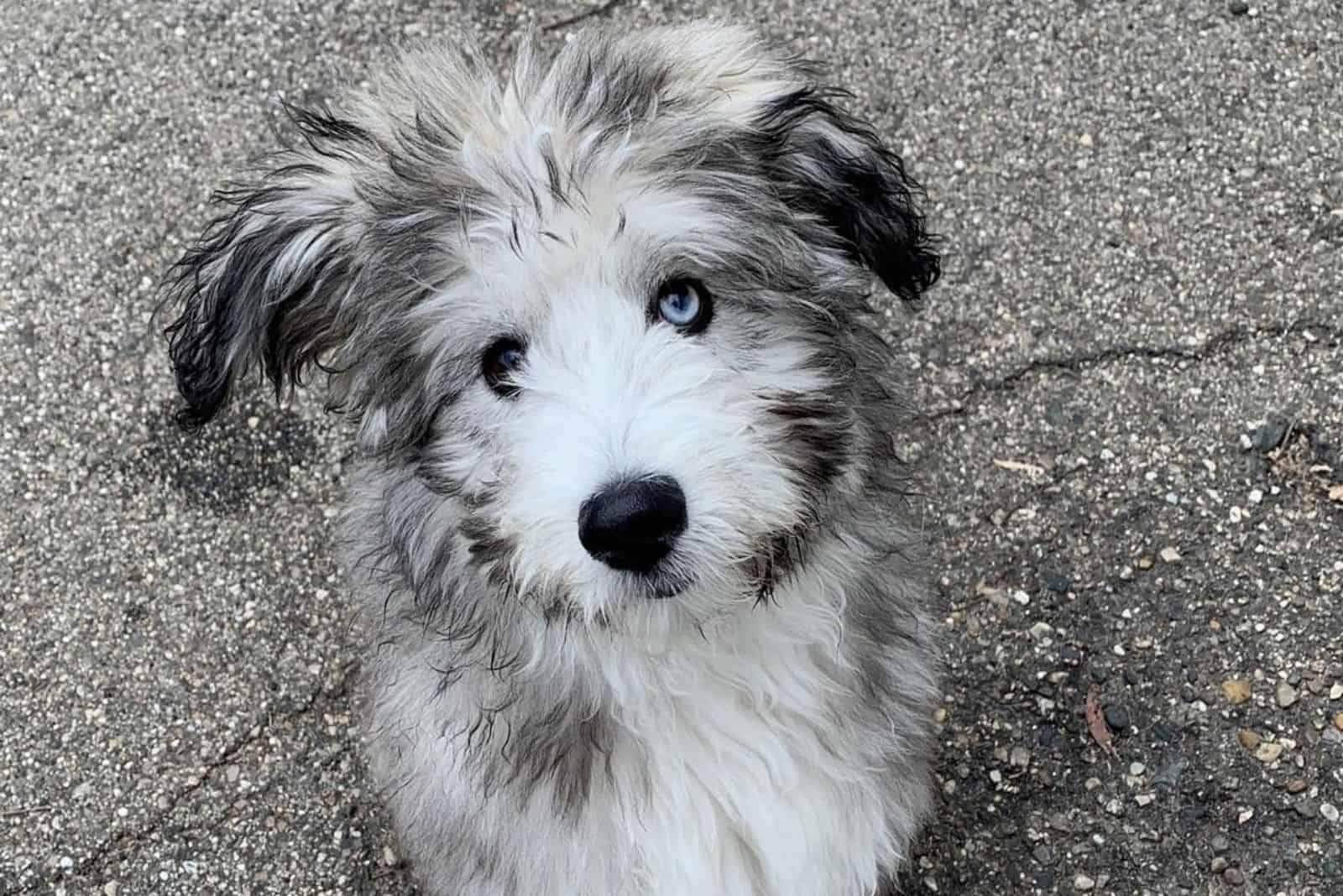
A Husky Poodle mix is a medium to large dog, with height ranging from 13 to 22 inches and a weight of 45 to 60 pounds. Females are typically smaller than males. Their size also depends on what type of Poodle was used in the breeding process, miniature or standard.
They can inherit their physical traits from either parent’s side.
Poodles come in three different sizes. The smallest ones are Toy Poodles at around 10 inches of height and about 6 to 9 pounds of weight, while the miniature type stands 11 to 15 inches tall and weighs 15 to 17 pounds. According to the standard Poodle growth chart, these are the biggest Poodles, with a height of around 22 inches and a weight of between 45 and 70 pounds.
They are elegant, squarely built dogs that carry themselves proudly. They’ve got oval-shaped dark eyes. Their long, straight muzzle is in proportion to the moderately rounded skull, and their ears are floppy.
These single-coated dogs with curly hair texture come in a variety of colors, ranging from black, grey, brown to cream, apricot, merle, parti, phantom, blue, red, and chocolate.
The Siberian Husky is a medium-sized working dog whose weight is between 35 and 60 pounds and a height of 20 to 23 inches. Nowadays, we recognize teacup Huskies as a subcategory, but many experts claim breeding and raising teacup puppies is unethical. They are moderately compact dogs with a strong build that helped them carry out their tasks in the cold northern weather.
Their almond-shaped eyes can be blue or brown in color, sometimes even one of each. The ears are erect and triangular. They’ve got medium-length muzzles with teeth closing in a scissor bite.
Unlike Poodles, they are double-coated dogs, with straight hair on the top-coat. When it comes to their color, it can be anything from black, grey, brown, to pure white.
Considering how different these two purebred dogs are, it’s hard to tell what exactly their mix will turn out to be.
They tend to look more like Poodles with Husky colors. Their eyes are usually dark, but some inherit the Husky’s blue eyes. Like their Poodle parent, they’ve got floppy ears, and their noses are black.
Huskypoos’ coats and grooming requirements
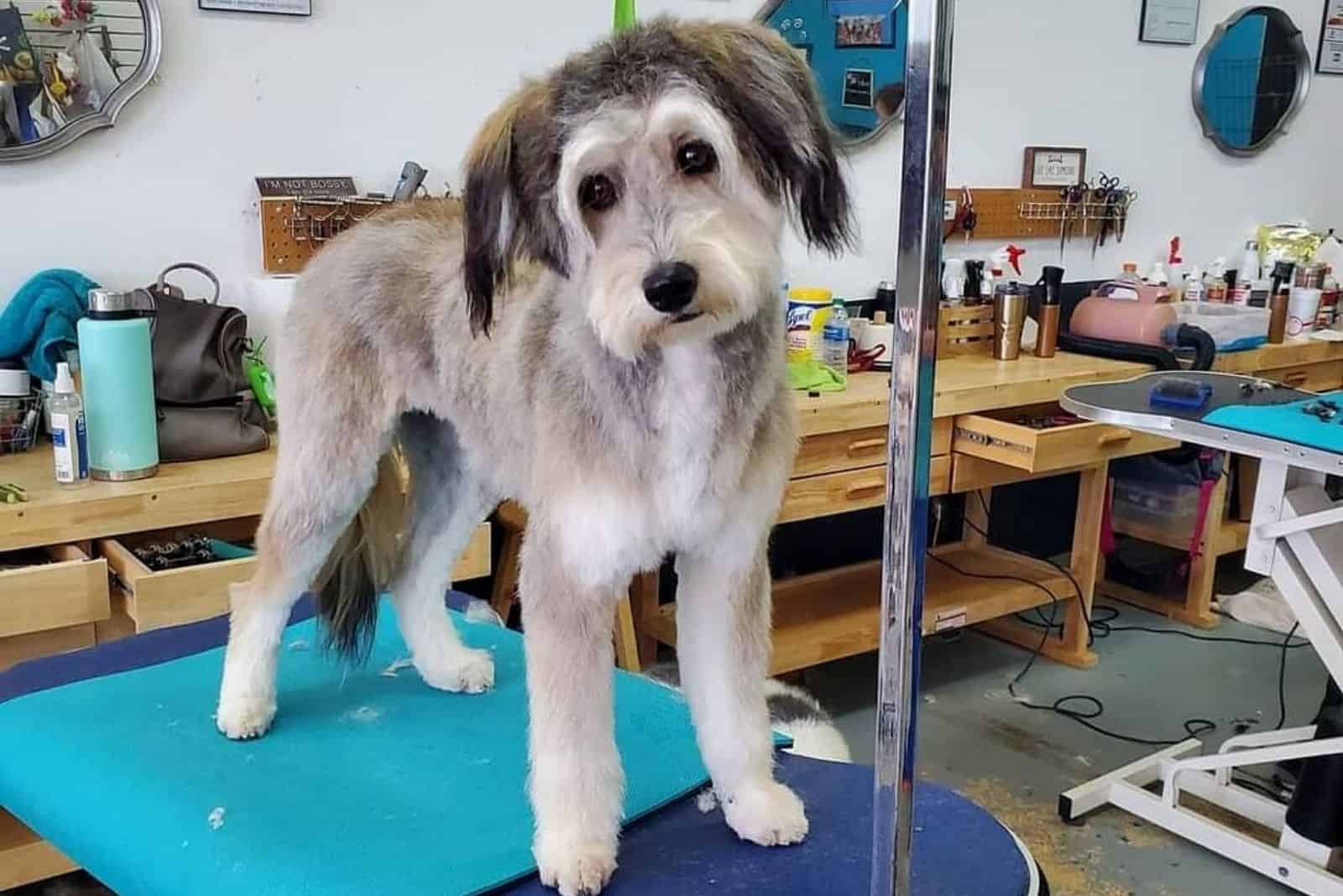
What a Huskypoo ‘s coat will be like depends on what traits it inherits from each parent. Mixed breeds are always unpredictable. Puppies from the same litter can even have widely different appearances.
A puppy can be born with either a single or double coat since Poodles and Huskies differ in this aspect.
These two dogs also have different hair textures, so their mix’s fur can vary from curly to straight, though it’s most often medium-length and wavy.
Poodles can be quite colorful, while Huskies range from black, grey to white. The Siberpoo ‘s coat is usually multi-colored with different color combinations and markings on the head and chest. The main colors they come in are white, grey, and black, but occasionally puppies inherit their Poodle parent ‘s brown, apricot, or red fur.
The type of grooming these pups require also depends on their genetics. Those with thick, dense coats need to be brushed daily to avoid hair tangles and matting, while for those with lighter, wavier hair, brushing once or twice a week should be enough.
Most dog owners take them to a professional groomer every few months for a regular clipping.
Bathing them too often washes away the natural body oils, which protect the skin from getting too dry. Unless your Siberpoo gets all dirty from playing in the mud, a monthly bath should do the job of keeping them clean.
Your grooming sessions should also include regular toothbrushing and nail-clipping. If you get them used to this while they’re young, it will be easier for the both of you later on.
Brushing a dog’s teeth once or twice a week is good for their overall health, plus it eliminates the bad breath your nose has probably had the displeasure of encountering many times. Nail-clipping is typically done once a month, and it can be a very frustrating experience for both the dog and human.
Do Siberpoos shed?
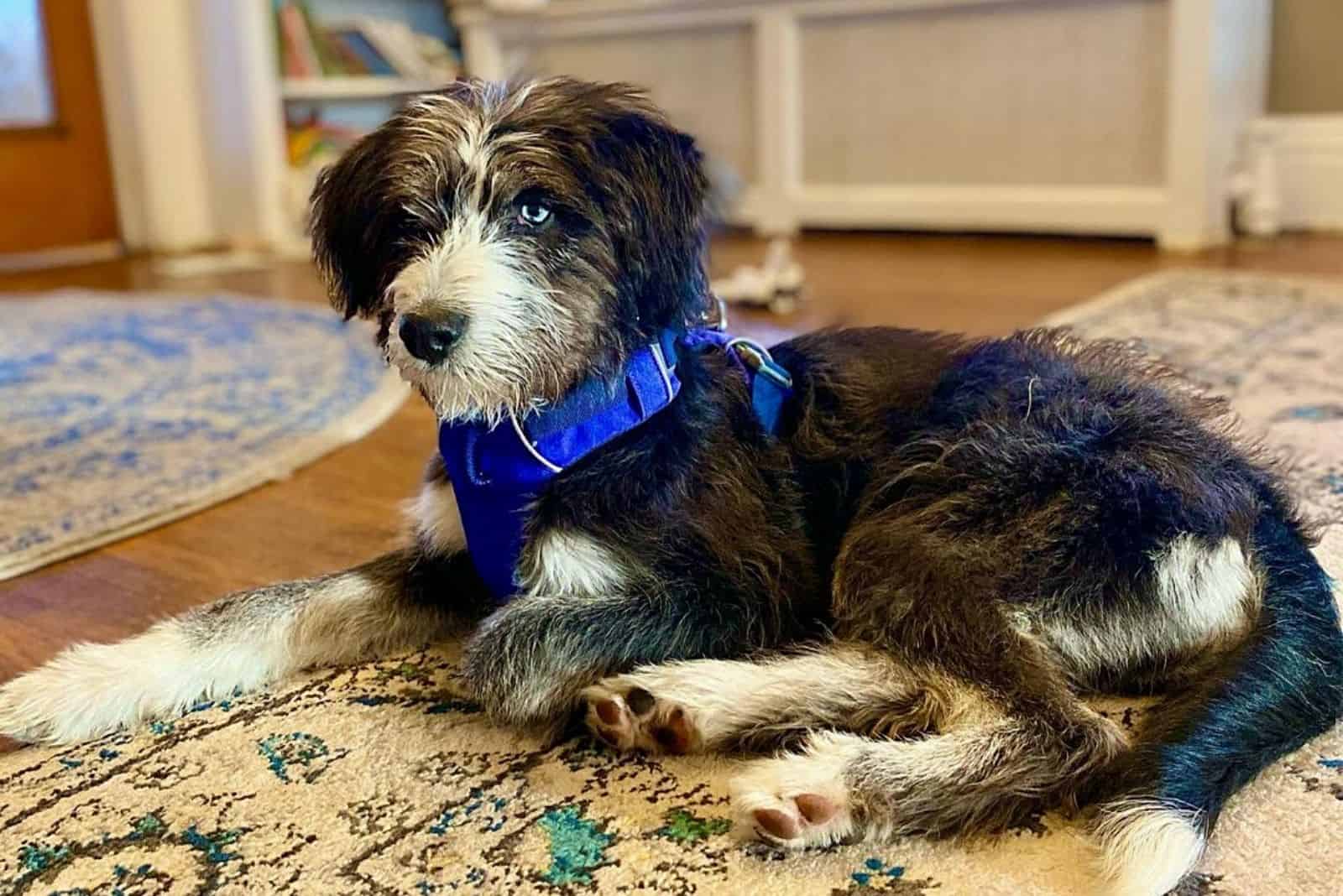
A frequently asked question about all Poodle mixes is whether they shed. Poodles are known for their hypoallergenic coats, so many assume their offspring will have them too. Like all other characteristics, the shedding amount also depends on the specific puppy’s genetic makeup. This means that some Siberpoos have non-shedding coats, while others can be heavy-shedders.
The Poodles’ low-shedding coats make them great companions for allergy sufferers. On the other hand, Huskies blow their undercoats seasonally, and they can shed quite a bit throughout the year.
Most Siberpoos inherit a combination of these traits, making them average-shedding dogs. Those resembling the Poodle’s side of the family can be hypoallergenic, while those that get their coats from their Husky parents will probably shed a lot.
The amount of shedding can be controlled to an extent by regular grooming. Brushing your pup’s hair is not only an excellent bonding activity, but it also ensures you won’t have to clean all the time.
However, if you’re living with someone who has a severe dog allergy, maybe the Huskydoodle isn’t the right choice for a pet.
What is the Huskypoo’s temperament like?
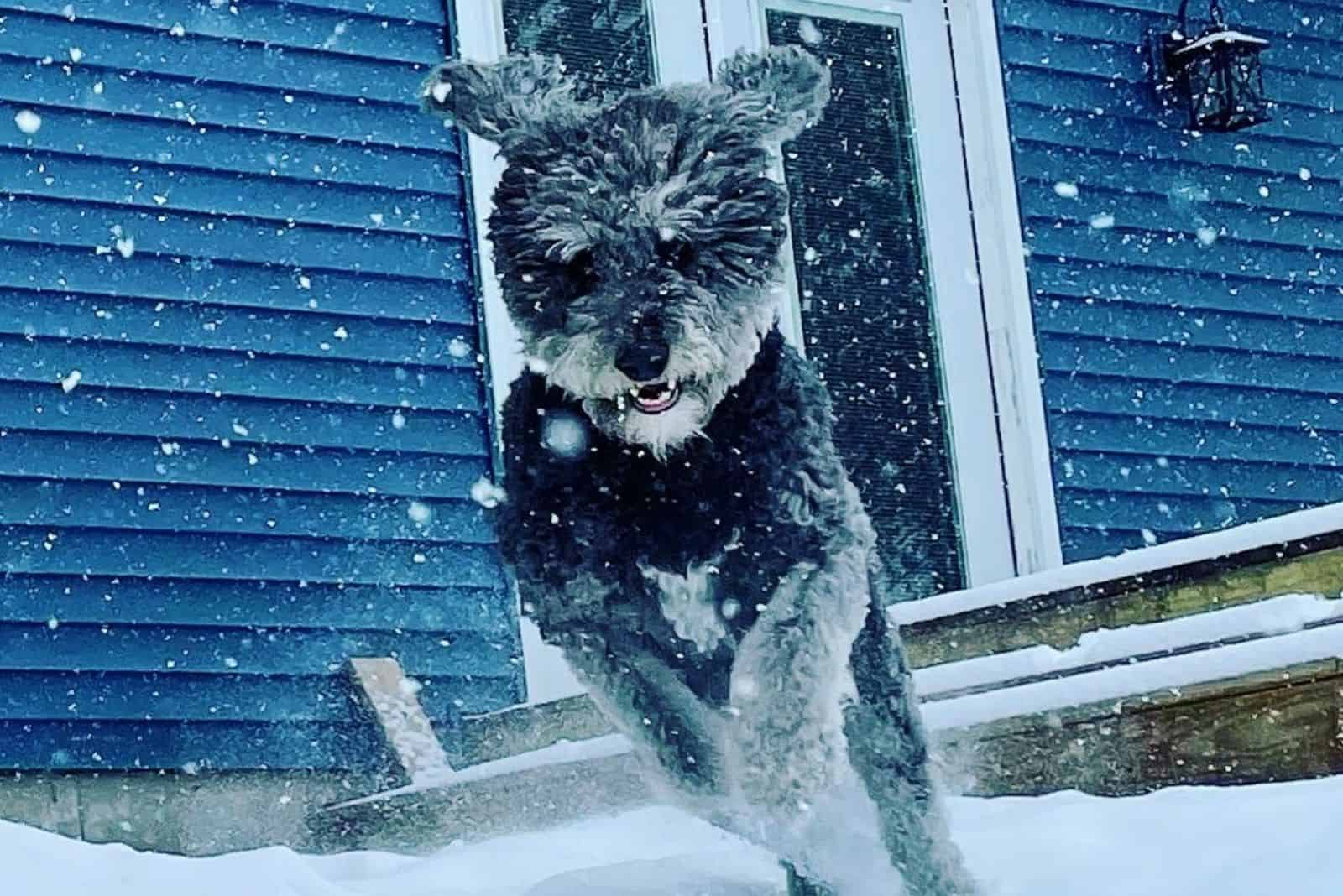
Each dog has a unique personality created when their fundamental nature is shaped by the environment they grow up in. What a specific pooch ’s temperament will be depends on what character traits they inherited, as well as what their experiences in the world have been like.
The AKC describes Poodles as active, intelligent, and proud dogs, while they call Siberian Huskies friendly, gentle, alert, and outgoing. Their mix can have any of these traits.
In general, Huskapoos are loving, affectionate dogs that make perfect companions for a variety of owners.
However, their affectionate nature has a downside. They can be very emotionally dependent on their humans because of it, making them prone to separation anxiety. They need a lot of attention, and they hate being ignored or left alone for too long.
If you spend a lot of time away from home, they might not be the right choice for you.
For pups that exhibit behavioral problems, the chances are that separation anxiety is the reason behind them. Don’t worry, though – they can be corrected with some love and lots of hard work.
Proper socialization during puppyhood can prevent these problems from developing. Good thing they grow up fast and become easier, so you don’t have to deal with the troubling puppyhood for too long.
With both parents being incredibly intelligent, it’s no wonder the Siberpoo is smart as well. Always out to please their owners, these pups pick up new tricks quickly, but their stubbornness can sometimes make them hard to train.
These high energy, active dogs need a lot of playtime and mental stimulation to combat boredom. A bored dog often becomes destructive, so it’s better to keep them entertained if you don’t want to find chewed-up shoes and shredded toilet paper when you come home.
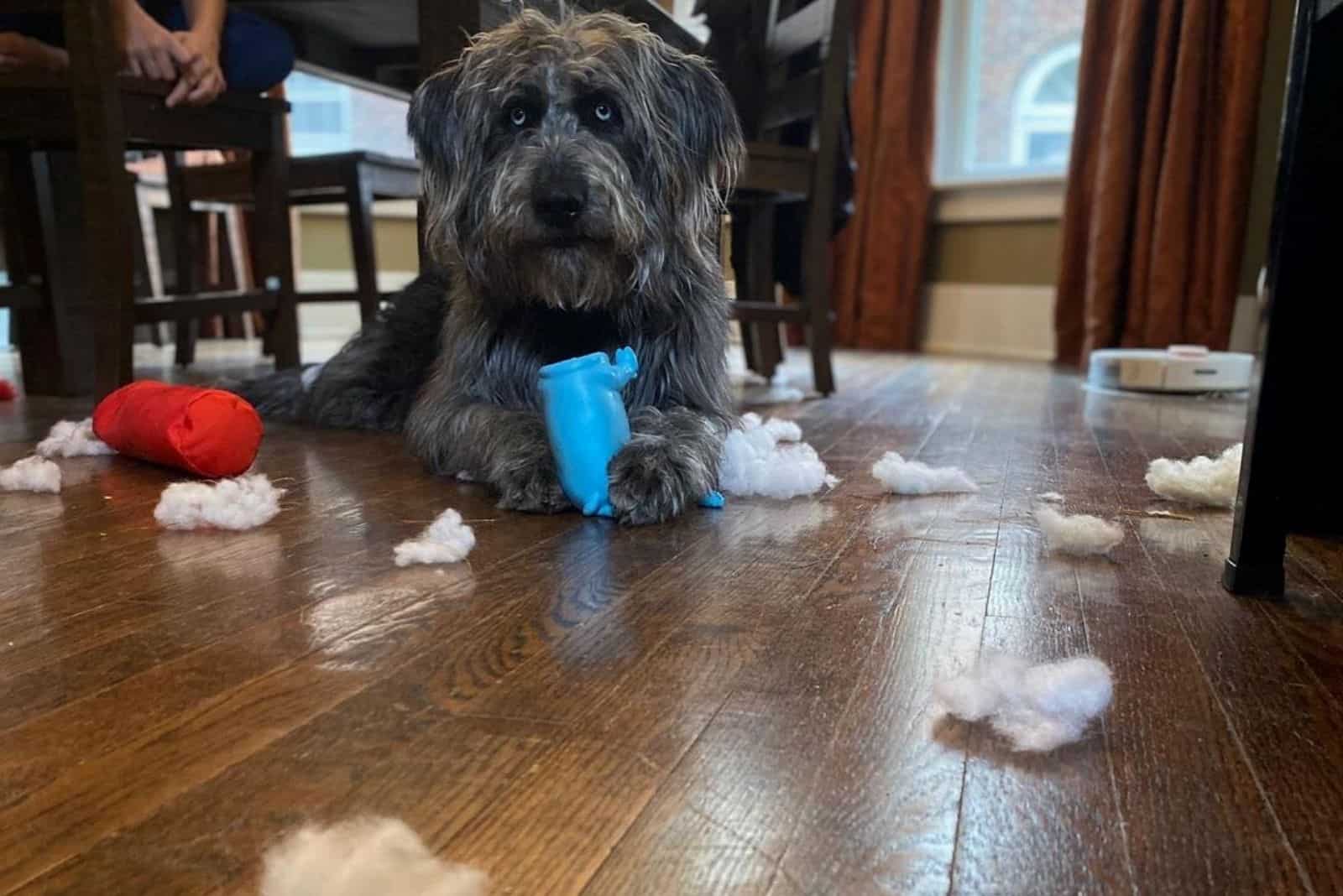
Huskypoos love to snuggle on the couch, but they’ll jump at the opportunity to go out and have some fun. This makes them great exercise partners for more active people.
Overall, with proper training and early socialization, these puppies will grow into lively, obedient dogs that bring joy into the lives of everyone they encounter.
Do they get along with children?
The Huskydoodle ’s friendly nature makes them great family pets, especially for families with older kids that lead an active lifestyle.
Considering their size and high energy levels, they may not be as suitable for those with young children. It’s always best to keep an eye out when letting kids interact with dogs, as they can hurt each other unintentionally.
However, if you do decide to bring one of these puppies into your home, be sure to slowly introduce them to all the new situations they’ll be finding themselves in. That’s the best way to prevent future negative experiences and to ensure the happiness and safety of all family members.
Do they get along with other pets?
Huskypoos demand a lot of attention, so they can get jealous when they’re introduced to other pets in the house. These high energy pups might find it entertaining to chase the cat around, especially if they’ve never been around one before.
That’s exactly why socializing your dog is so important. It prevents negative behavior and makes it easier to bring a new pet home later on.
The Huskapoo’s exercise requirements
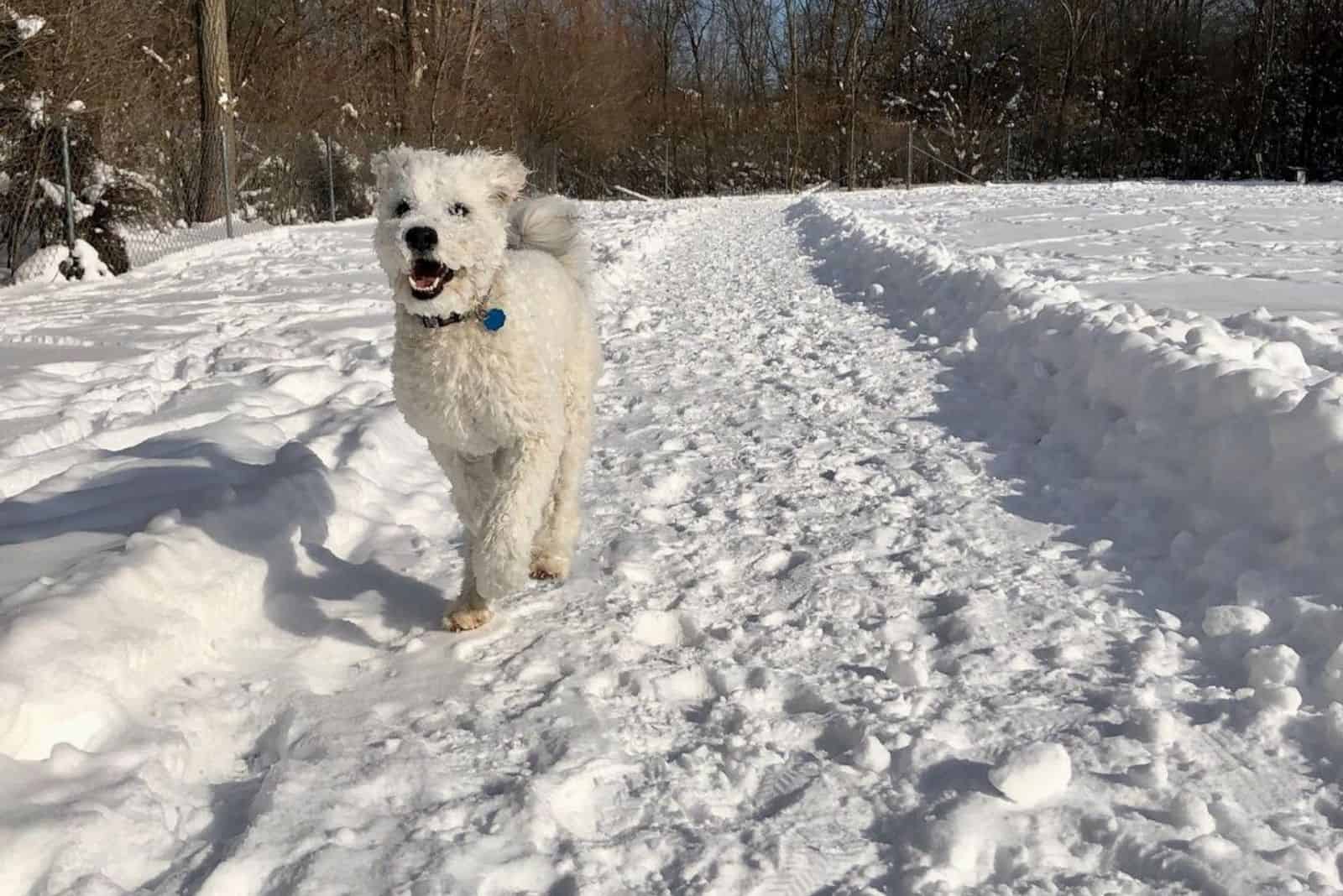
Huskypoos are extremely active dogs, which is not surprising considering they come from hard-working parents. Both Huskies and Poodles initially had very physically demanding tasks, so they needed a lot of energy to do their jobs.
The Huskydoodle needs at least an hour of exercise a day to burn off its extra energy. Whether it’s a walk, run, or playtime in the dog park, they are always ready to go.
They also need a lot of mental stimulation, being the smart pups they are. Investing in some interactive dog toys should do the trick to keep boredom away. Otherwise, they might resort to destructive behavior.
If you love camping, hiking, or just being outdoors, these pooches will happily accompany you on your adventures. However, if you’re more of a couch potato type, a calmer dog is probably a better choice.
Health issues
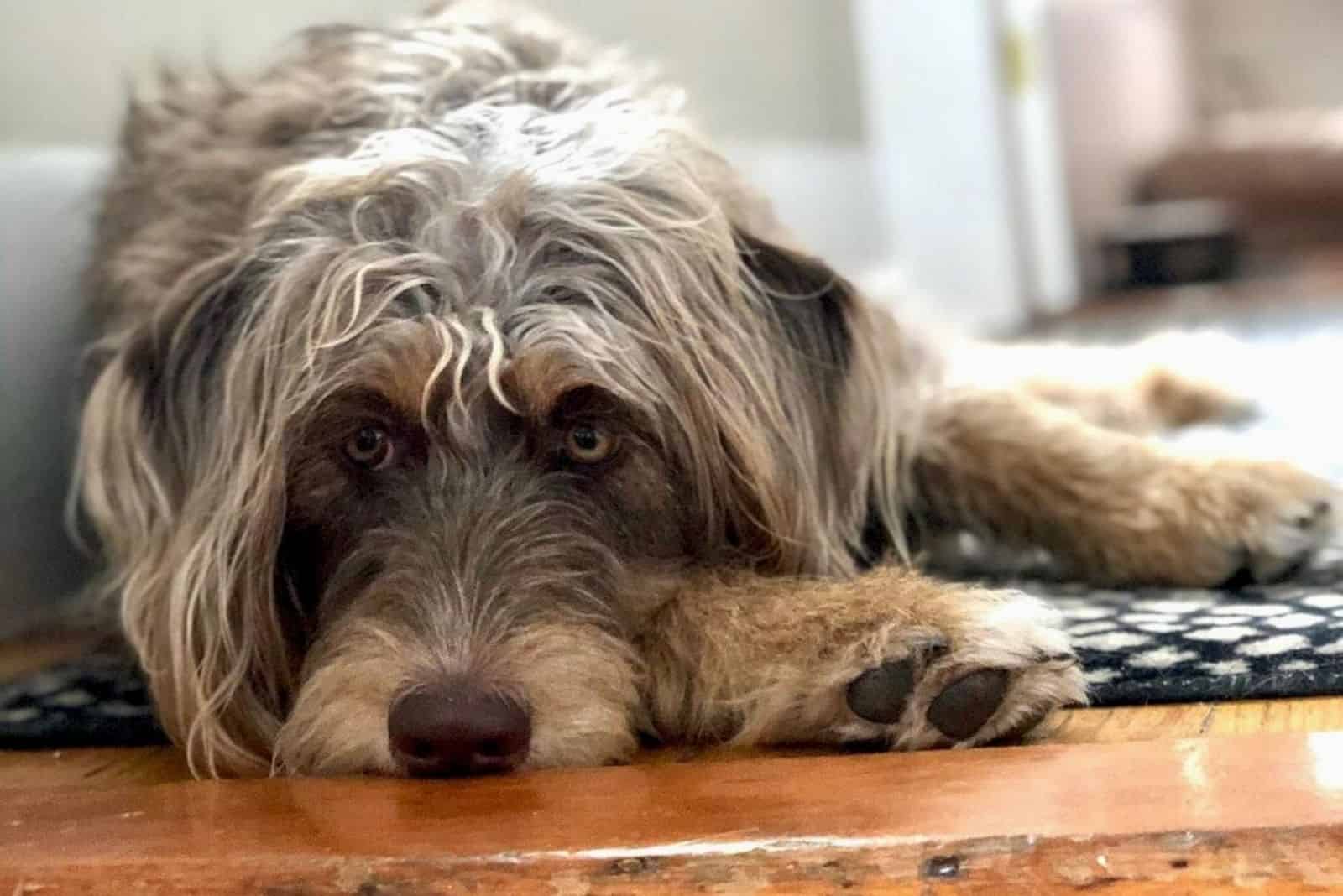
Siberpoos have a life expectancy of about 10 to 13 years. This may seem short to you, as you’d like to have your furry friend around for as long as possible, but it’s the average lifespan of medium-sized dogs.
Mixed breeds, in general, tend to have fewer health problems than their purebred parents due to hybrid vigor. Even though Huskypoos are typically healthy dogs, they can still inherit genetic diseases from either side of the family.
The main health concerns for this breed are:
• Hip dysplasia
Hip dysplasia is a common problem for both Huskies and Poodles, which increases the chances of their mix puppies inheriting it. It’s a skeletal disease many dogs have to deal with, especially the larger breeds.
In dogs with this condition, the ball and socket of the hip don’t fit properly, usually causing a lot of pain and, if not treated in time, the complete loss of joint function.
Some of the signs that a dog might be suffering from it include decreased activity and range of motion, stiffness or limping, loss of thigh muscle mass, and difficulty running or jumping. If you notice any of these in your Poosky, be sure to contact a vet.
• Legg-Calve-Perthes disease
The same signs could also indicate that a dog has Legg-Calve-Perthes disease. This is another genetic condition that leads to the deterioration of the hip joint, but it usually affects only one leg. The head of the ball begins to degenerate, and over time, it can lead to arthritis.
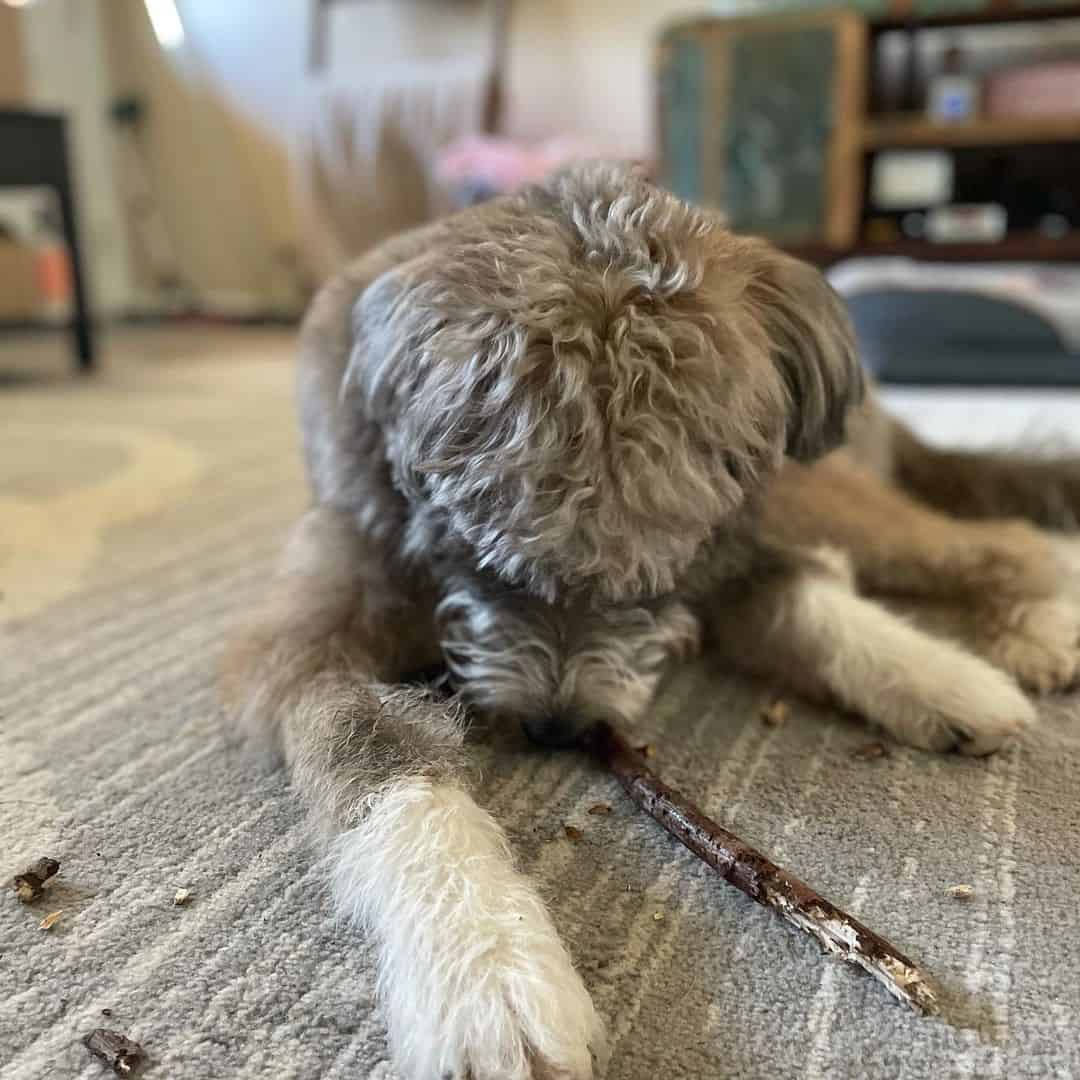
Photo from @weston_thepoosky
• Gastric dilatation volvulus
Gastric dilatation volvulus, commonly seen in larger dogs, is a disease Pooskies can get from their Poodle parent ’s side. In its early stages, it causes simple gastric dilatation or bloat, but it can progress into a very serious concern, sometimes ending with a fatal outcome.
• Patellar luxation
Patellar luxation is a condition where the kneecap moves out of its normal location. It ranges from mild, where the kneecap only dislocates occasionally, to moderate or severe forms, where it’s dislocated most of the time. The discomfort causes the dog to put his weight on one leg, which can lead to other injuries and may result in arthritis and decreased mobility as the dog ages.
• Hypothyroidism
Hypothyroidism is a health problem that occurs when a dog doesn’t produce enough of the thyroid hormone. The symptoms of it are sudden weight gain, slowness, and lethargy.
• Epilepsy
Both Siberian Huskies and Poodles are commonly afflicted with epilepsy, which is why the Siberpoo is predisposed to it. A dog with this condition has recurrent seizures due to abnormal brain activity.
Apart from these diseases, Huskapoos are also prone to developing different eye conditions and skin allergies.
Training the Huskydoodle
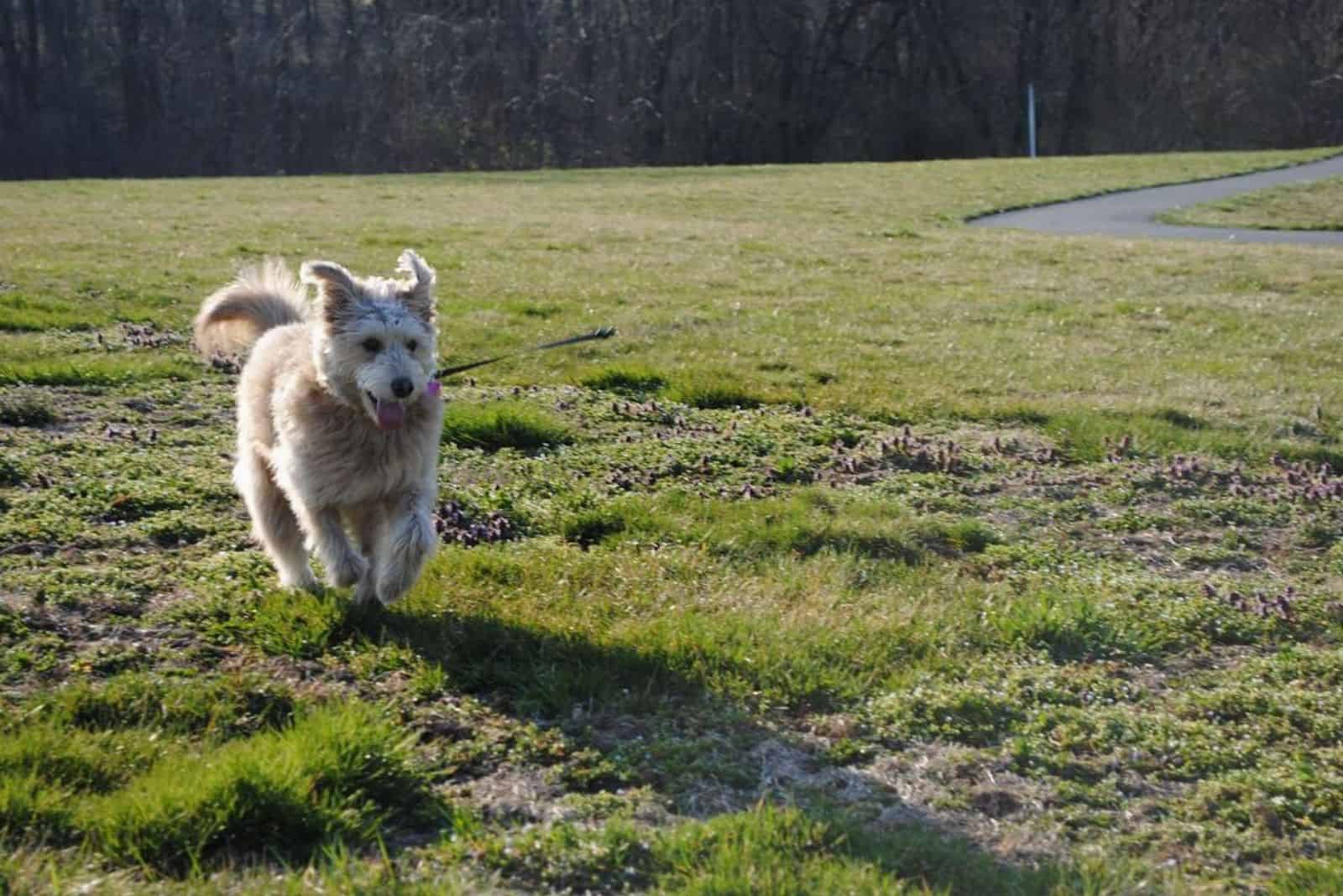
For stubborn creatures like Pooskies, proper training is a must. If you don’t set boundaries right from the beginning and let them know who has the final word, don’t be shocked when they start to test you as they get older.
They can learn quickly since they are quite intelligent, but it’s your job to make the training fun enough for them to actually want to learn. Training sessions also shouldn’t be too long because they have short attention spans.
Like with all other dog breeds, the earlier you start with obedience training and socialization, the better.
To shape a mischievous puppy into a well-behaved dog, you’ll need to build a strong relationship and create structure. This is why positive reinforcement brings the best results; it helps the dog associate good manners with a positive outcome and strengthens their trust in you.
Once you’ve gained your puppy’s trust, you can go onto leash-training and teaching them basic commands. It will take a lot of patience and understanding, but just hang in there, and it will be worth it.
Before you start taking strolls around the neighborhood, your pup will first need to be leash-trained. Dogs are not born with collars or harnesses on them, so it can be scary to have something restraining their movement all of a sudden. That’s why they need to adjust to it in a safe environment.
The most important command your dog needs to master if you’re going to let them play off-leash outside is ‘come.’ Unless they do it perfectly every time and with different distractions around, it simply isn’t safe to let them walk freely.
Other basic commands include sit, stay, down, and leave it, and they’re not much of a challenge for any dog when they’re motivated enough.
Once you’ve got these basics down, you should be able to enjoy having a playful but polite pup by your side.
Since Huskypoos are prone to separation anxiety, it’s also important to get them used to being alone while they’re still young. This will prevent any anxiety-related behavioral issues from developing.
It’s never too late for dogs to learn, so even if your dog already has some problems, they can be fixed with lots of love and hard work.
How much does a Husky-Poodle cost?
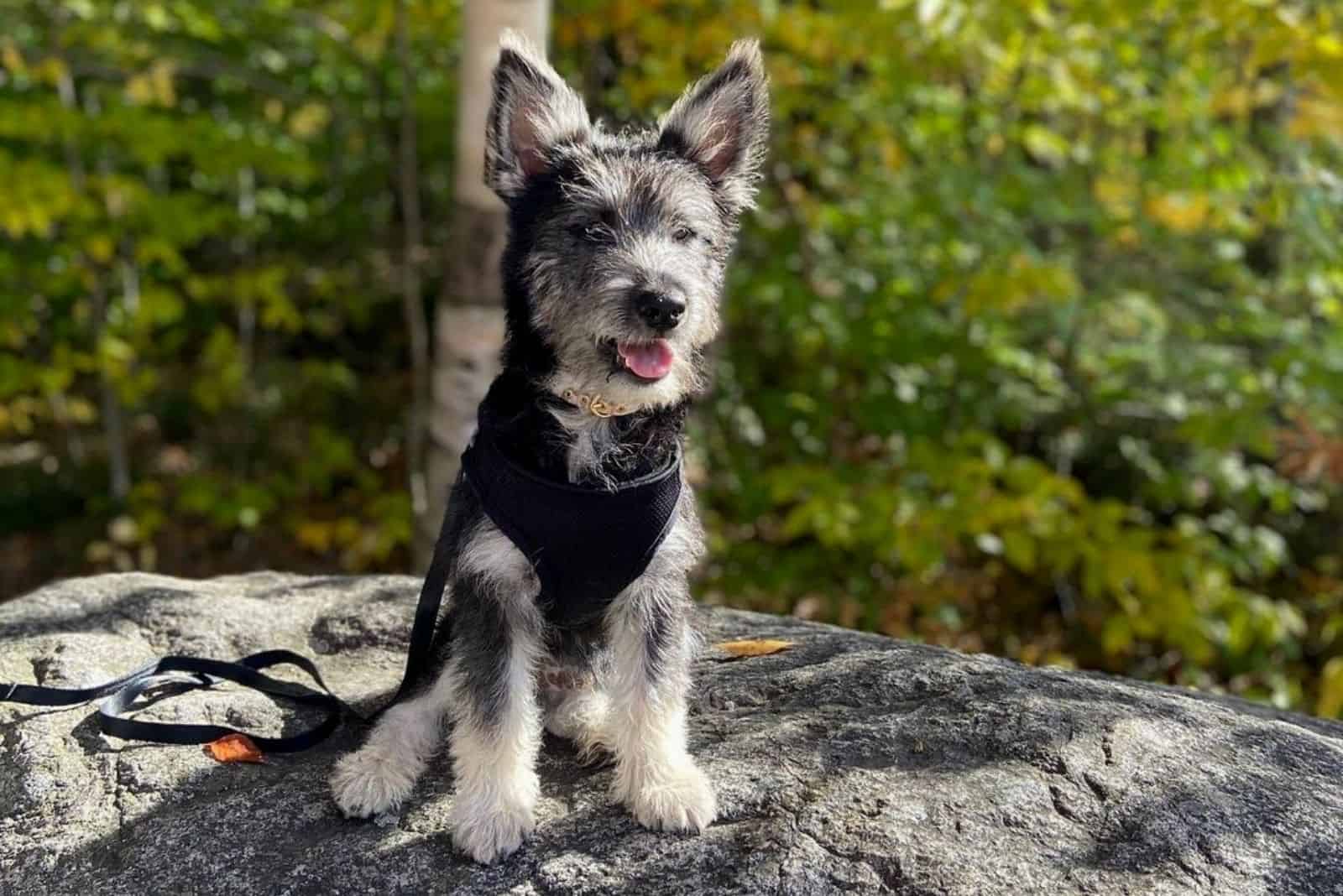
The price of the Husky Poodle mix puppy ranges between $700 and $1,500, depending on your location, the breeders, and the dog’s lineage.
There is also the cost of owning a dog, which includes food, grooming, vet visits, etc., and can be anything from $100 to $400 a month.
Getting your puppy from a reputable breeder is more expensive, but it has many benefits. They put a lot of effort into properly taking care of the dogs, so only dogs that pass the necessary health checks are used for breeding.
This decreases the chances of your puppy inheriting the genetic diseases we’ve mentioned above.
You can also ask the breeder to meet the puppy’s parents to give you an idea of what to expect from its fully-grown appearance and character.
Puppy mills, on the other hand, are only looking to make a quick buck, often neglecting dogs in the process. They may be less expensive, but do you really want to support such unethical practices?
Is the Husky Poodle mix the right dog for you?
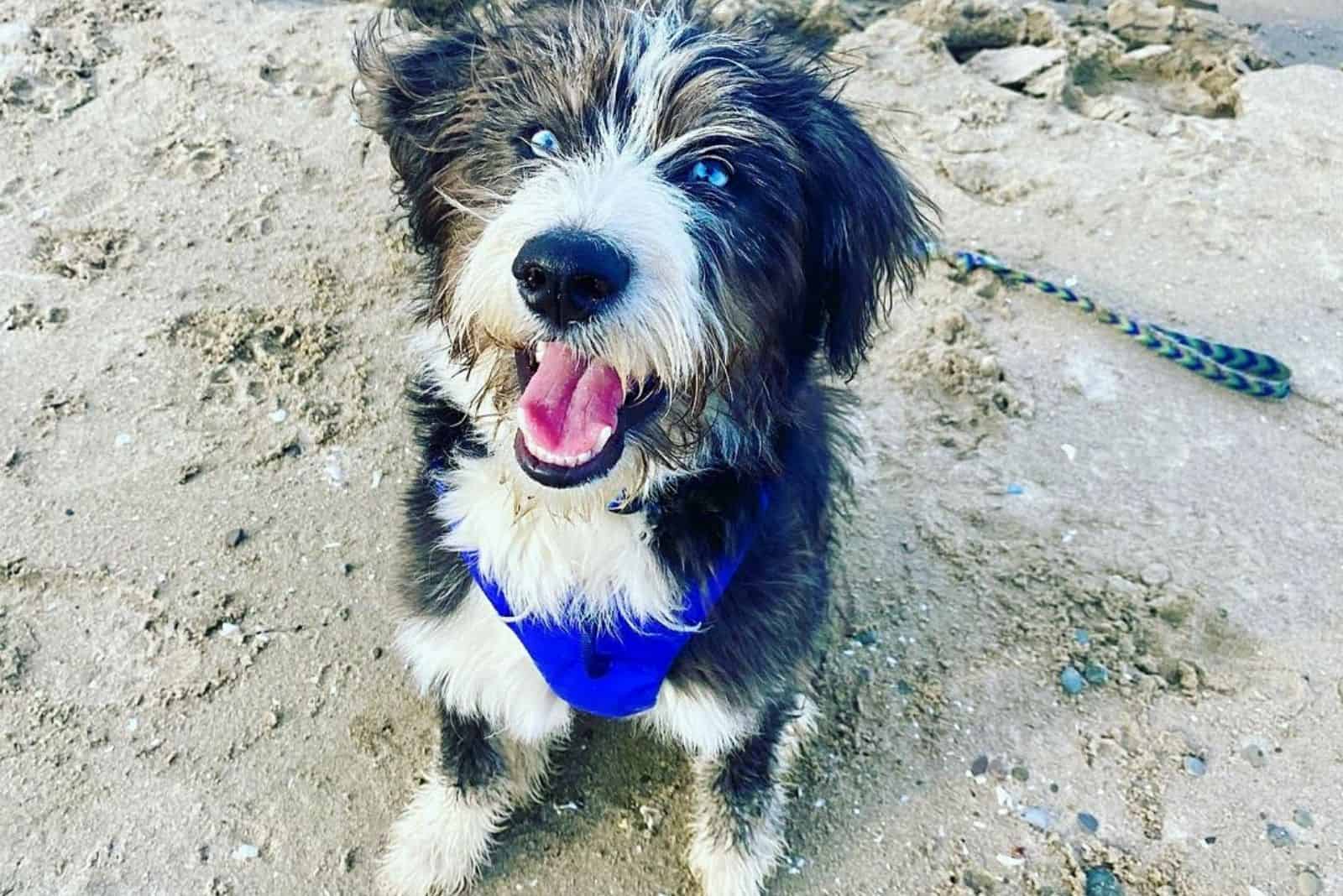
The Husky Poodle mix combines all the best Siberian Husky and Poodle traits into one furry body. There’s no denying they’re magnificent dogs, but are they the right pets for you?
Being medium to large-sized dogs with a lot of energy, they need space. They’re best suited to a house with a yard, though they can live in an apartment if you give them enough outdoor time.
Since they’re a combination of such different breeds, it’s hard to tell what Huskypoo puppies will look like. They often end up with a wavy, black, white, or grey coat and blue or brown eyes. If looks are important to you, meeting the puppy’s parents might help with your decision.
You’ll need to make time in your schedule for their grooming sessions. They require regular hair brushing and trimming as their hair grows continuously.
When it comes to fur, there’s also the matter of shedding. If the main reason you’re looking into getting a Husky-Poodle mix is that you heard they’re hypoallergenic, you might want to reconsider.
Huskapoos are, on average, medium-shedders, though they can be more allergy-friendly if they inherit the Poodle’s low-shedding coat. The other, Husky parent, is prone to severe shedding.
These high-energy dogs are not a good fit for lazy people, but they are perfect companions for those that lead an active lifestyle. They’re also not a good choice for anyone who doesn’t spend much time at home as they need a lot of attention and don’t do well when left alone for too long.
If you do decide to get yourself a Huskydoodle, they’ll enrich your life with their lively, affectionate personalities. They can be amazing family dogs that get along great with children and other pets.
On the other hand, if you don’t feel like you would suit each other, you might want to check out some other Poodle mixes.
The most popular are Labradoodles, a mix between a Labrador Retriever and a Poodle. Among the larger breeds, there is also the Goldendoodle ( Golden Retriever – Poodle mix ), while the popular smaller ones are Cavapoos, Cockapoos, and Maltipoos.
Read Next:
• Dalmatian Poodle Mix: A Spot On Adorable Doodle!
• 17 Poodle Breeders In California – Best Golden State Breeders
• The Top 12 Poodle Breeders In Oregon – Places To Get Poodles
